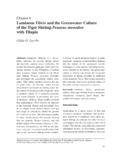Perlihatkan publikasi sederhana
Bacterial loads in hatcheries and virulence of Vibrio spp. to larvae of the tiger shrimp Penaeus monodon
| dc.contributor.author | Torres, James L. | |
| dc.contributor.editor | Bagarinao, Teodora | |
| dc.date.accessioned | 2018-03-05T08:13:56Z | |
| dc.date.available | 2018-03-05T08:13:56Z | |
| dc.date.issued | 2007 | |
| dc.identifier.citation | Torres, J. L. (2008). Bacterial loads in hatcheries and virulence of Vibrio spp. to larvae of the tiger shrimp Penaeus monodon. In T. U. Bagarinao (Ed.), Research Output of the Fisheries Sector Program (Vol. 2. Reports on Fisheries and Aquaculture, pp. 87-92). Quezon City, Philippines: Bureau of Agricultural Research, Department of Agriculture. | en |
| dc.identifier.isbn | 9718511776 | |
| dc.identifier.uri | http://hdl.handle.net/10862/3270 | |
| dc.description.abstract | Shrimp hatcheries are high-density systems and are prone to diseases. A small-scale and a large-scale hatchery for the tiger shrimp Penaeus monodon in Iloilo, Philippines were monitored over two months for water quality and shrimp survival. Water quality (water temperature, pH, salinity, dissolved oxygen, and specific gravity) was not significantly different between the two hatcheries. However, the small hatchery seemed to favor survival of eggs to early postlarval stages, whereas the large hatchery favored the survival of late postlarvae. The normal microflora and bacterial loads of tiger shrimp eggs, larvae, postlarvae, and rearing water were determined to identify the dominant bacteria and potential pathogens. Shrimp eggs harbored the lowest heterotrophic bacterial counts. The counts increased from the nauplii to the mysis stages, decreased during the mysis stage, and then gradually increased in the older larvae. Bacterial loads in the rearing water reflected those in raw sea water and reservoir-aged sea water. Vibrio, Pseudomonas, and Aeromonas were not detected in eggs but were found in postlarvae. Ubiquitous in sea water, these bacteria increased with the build-up of organic matter. The bacterial load in the water adversely affected larval survival. Forty bacterial strains were isolated from tiger shrimp eggs, larvae, postlarvae, from the feeds, and from the rearing water. These were tested for biochemical characteristics and segregated into eight groups or genera. Six genera were found in the mysis and five genera in the postlarvae. The Vibrio species were dominant. Only Escherichia spp. were present in feeds, whereas five genera were present in the rearing water. Only Vibrio and Pseudomonas were present in both larvae and water. Moraxella, Aeromonas, and Klebsiella were found in larvae but not in rearing water. Micrococcus and coryneforms were found only in rearing water. Four Vibrio isolates were tested for virulence against shrimp postlarvae at inoculation densities of 102 and 107 cfu/ml. The four Vibrio species caused mortality of postlarvae, and more at the higher inoculation density. The most virulent was Vibrio anguillarum—30% of postlarvae died after 24 h exposure to a bacterial density of 102 cfu/ml, and all larvae died after 48 h at 107 cfu/ml. Shrimp hatcheries must have protocols for hygiene and sanitation and for disease prevention and control. | en |
| dc.language.iso | en | en |
| dc.publisher | Bureau of Agricultural Research, Department of Agriculture | en |
| dc.subject | Penaeus monodon | en |
| dc.subject | Vibrio | en |
| dc.subject | Vibrio anguillarum | en |
| dc.subject | Philippines | en |
| dc.title | Bacterial loads in hatcheries and virulence of Vibrio spp. to larvae of the tiger shrimp Penaeus monodon | en |
| dc.type | Book chapter | en |
| dc.citation.spage | 92 | |
| dc.citation.epage | 87 | |
| dc.citation.bookTitle | Research Output of the Fisheries Sector Program | en |
| dc.subject.asfa | virulence | en |
| dc.subject.asfa | pathogenic bacteria | en |
| dc.subject.asfa | shrimp culture | en |
| dc.subject.asfa | hatcheries | en |
| dc.subject.asfa | disease control | en |
| dc.subject.asfa | bacterial diseases | en |
| dc.subject.asfa | crustacean larvae | en |
| dc.subject.scientificName | Penaeus monodon | en |
Files in this item
| Files | Size | Format | View |
|---|---|---|---|
|
There are no files associated with this item. |
|||




